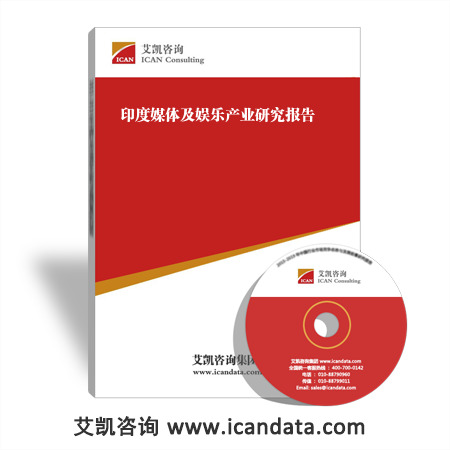数据来源与研究方法:
- 对行业内相关的专家、厂商、渠道商、业务(销售)人员及客户进行访谈,获取最新的一手市场资料;
- 艾凯咨询集团对长期监测采集的数据资料;
- 行业协会、国家统计局、海关总署、国家发改委、工商总局等政府部门和官方机构的数据与资料;
- 行业公开信息;
- 行业企业及上、下游企业的季报、年报和其它公开信息;
- 各类中英文期刊数据库、图书馆、科研院所、高等院校的文献资料;
- 行业资深专家公开发表的观点;
- 对行业的重要数据指标进行连续性对比,反映行业发展趋势;
- 通过专家咨询、小组讨论、桌面研究等方法对核心数据和观点进行反复论证。
报告简介:

摘要
Countries covered: India
Media and Entertainment (M&E) industry in India was worth INR402.43 billion (USD9.12bn) in 2006, a growth of 13.98% over 2005, which is higher than GDP growth rate. It is expected that the industry will grow at 17.49% in 2007 to reach a size of INR472.81 billion.
During 2000-06, the radio industry grew at a CAGR of 52.41% and is expected to grow at a CAGR of 34.17% during 2006-10.
SCOPE OF THE REPORT
It provides an overview on Indian media & entertainment Industry with reference the market size, regional segmentation, key trends in M&E Sector.
- An assessment of Indian M&E industry covering overall industry scenario, various segments etc.
- It covers the growth drivers with reference to demographic changes, changing distribution channels etc.
- It profiles major players in film & television, printing & Publishing industry with information on company, shareholding pattern, financial performance, strategy of the company.
- It also assesses regional markets along with mergers & Acquisitions with reference to M&A deals.
- The report highlights the critical success factors in M&E industry along with the issues and challenges faced in the industry also it provides detail information on regulations involved in M&E sector.
- It presents a future outlook of Indian M&E industry.
BENEFICIAL FOR
- Companies in Media and Entertainment industry
- Investors & Consultants
- Industry Analysts
- Banks
- Hospitals
- Analysts and students.
- Education Institutes
- Venture Capitalist & Entrepreneurs
- Corporate
目录及图表
- 1. Executive Summary
- 2. Highlights
- 3. Industry Overview
- 3.1 Market Size
- 3.2 Media Growth Vs Gdp Growth
- 3.3 Regional Segmentation
- 3.4 Business Segments Of The M&E Industry
- 3.4.1 Audio
- 3.4.2 Video/Visual
- 3.4.3 Print Media
- 3.4.4 Others
- 3.5 Major Players
- 3.6 Key Trends In The M&E Industry
- 3.6.1 Deregulation
- 3.6.2 Convergence Of Entertainment, Information And Telecommunications
- 3.6.3 Lack Of Consolidation
- 3.6.4 All-pervasive Digital Technologies
- 3.6.5 Online Distribution Of Content
- 3.6.6 Emergence Of Interactive Tv And Digital Terrestrial Tv
- 3.6.7 Globalisation Of Filmed Entertainment Market
- 3.6.8 Menace Of Piracy
- 3.6.9 Funding In Entertainment (Films)
- 3.7 Conclusion
- 4. Growth Drivers
- 4.1 Favorable Demographic Changes
- 4.2 Improved Economic Conditions
- 4.2.1 How The Improved Economic Conditions Is Benefiting M&E Industry
- 4.3 Advertising Upswing
- 4.4 Changing Distribution Channels
- 4.4.1 Broadband Gaining Importance
- 4.4.2 Wireless
- 4.4.3 Satellite Radios
- 4.4.4 New Technologies
- 4.4.5 Regulations
- 4.5 Conclusion
- 5. Issues And Challenges
- 5.1 Introduction
- 5.2 The Thorns On The Rose
- 5.2.1 Infrastructure Is A Prerequisite
- 5.2.2 Human Resources - Finding The Right Talent
- 5.2.3 Adoption Of Next Generation Technologies
- 5.2.4 Business Challenges
- 5.2.5 Government Policy
- 5.3 Conclusion
- 6. Regional Markets
- 6.1 Introduction
- 6.2 Ncr
- 6.3 Mumbai
- 6.4 Chennai
- 6.5 Hyderabad
- 6.6 Conclusion
- 7. Major Players
- 7.1. Major Players In Film & Television Industry
- 7.2 Major Players In The Television Industry
- 7.2.1 Ndtv Ltd
- 7.2.2 Sun Tv Network
- 7.2.3 Cnbc-tv18
- 7.3. Major Players In Films And Television Industry
- .3.1 Adlabs Films Limited
- 7.3.2. Balaji Telefilms Ltd
- 7.3.3 Cinemax India Limited
- 7.3.4 Pvr Limited
- 7.3.5 Sahara One
- 7.3.6 Zee Entertainment Enterprises
- 7.4. Major Players In Printing And Publishing
- 7.4.1 Navneet Publications India Ltd
- 7.4.2 Ht Media Ltd
- 7.4.3 Jagran Prakash Ltd
- 7.4.4 Deccan Chronicle Holdings Ltd
- 8. Regulations
- 8.1 Introduction
- 8.2 The Wireless Act
- 8.3 Trai - Television Industry Regulations
- 8.4 Regulations Governing Television Broadcasting
- 8.5 Regulations Governing Film Exhibition
- 8.6 Regulations Governing Print Media
- 8.7 Recent Changes In Regulations
- 8.7.1 Conditional Access System (Cas)
- 8.7.2 Paving Way For Greater Foreign Presence In Indian Print Media
- 8.7.3 Government Clears Revenue-sharing In Fm Radio; Fdi Of 20% Approved
- 8.7.4 Government Of India Initiated New Rules Regarding Fdi In Fm Radio
- 8.7.5 Indian Government Plans To Hike Fdi Cap In Dth Ventures From 20%
- 8.8 Impact Of The Regulatory Changes
- 8.9 Conclusion
- 9. Mergers And Acquisitions
- 9.1 Introduction
- 9.2 Drivers For M&A In Media And Entertainment
- 9.3 M&A Deals In 2004
- 9.4 M&A Deals In 2005
- 9.5 M&A Deals In 2006
- 9.6 Outlook
- 10. Critical Success Factors
- 10.1 Introduction
- 10.2 Stay In Tune With The Changing Industry Dynamics
- 10.2.1 Expanding Into New Markets
- 10.2.2 Converge To Conquer
- 10.2.3 Quality Content Creation And Differentiation
- 10.2.4 Linking Communications With Entertainment: The Concept Of “particitainment”
- 10.2.5 Cross Industry Alliances
- 10.2.6 Vibrant Macro-economy
- 10.2.7 Adoption Of Global Best Practices - Corporatization 10.2.8 Marketing And After Sales Services
- 10.2.9 Regulations
- 10.2.10 Intellectual Property Management
- 10.2.11 Human Capital
- 10.3 Critical Success Factors: Evolving Each Day
- 10.4 Conclusion
- 11. Future Outlook Annexure
- I - Bibliography Annexure
- II - Abbreviation Annexure
- III - Regulations
娱乐
















